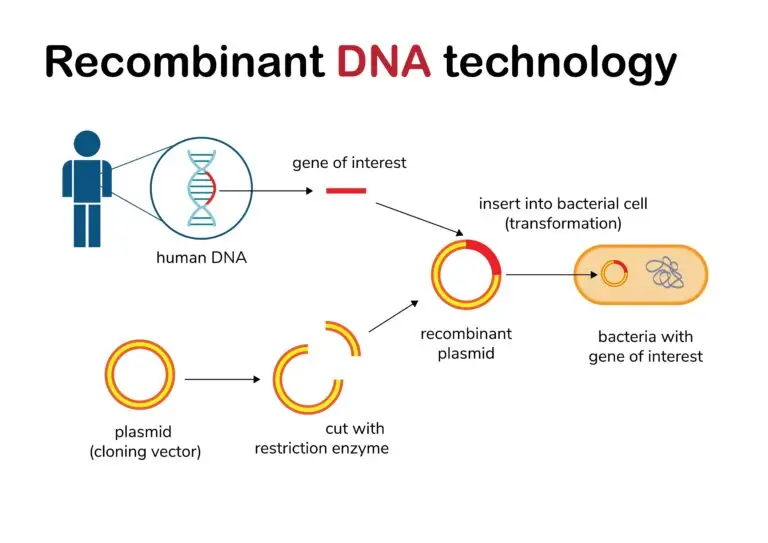Recombinant DNA

Table of Contents
What is Recombinant DNA
Recombinant DNA refers to DNA molecules formed by combining genetic material from different sources. This process involves the creation of novel DNA sequences that do not exist naturally by joining together segments of DNA from different organisms.
Recombinant DNA technology has become a fundamental tool in biotechnology, molecular biology, and genetic engineering, enabling the manipulation and modification of genes for various purposes.
Concepts of Recombinant DNA
Gene Cloning
Recombinant DNA technology allows the cloning of genes, which involves isolating and making copies of a specific gene of interest. This cloned gene can be inserted into a host organism, such as a bacterium or yeast, to produce multiple copies for further study or use.
Plasmid Vectors
Plasmids, small circular DNA molecules found in bacteria, are commonly used as vectors in recombinant DNA technology. A gene of interest can be inserted into a plasmid, and the plasmid is then introduced into a host organism, allowing the gene to be replicated and expressed.
Restriction Enzymes
Restriction enzymes, also known as restriction endonucleases, are proteins that can cut DNA at specific sequences. These enzymes are used to cleave DNA at precise locations, facilitating the insertion of foreign DNA into a vector.
Ligase Enzymes
DNA ligases are enzymes that can join together DNA fragments. They are essential for sealing the gaps created during the insertion of foreign DNA into a vector, resulting in a functional recombinant DNA molecule.
Recombinant Protein Production
Recombinant DNA technology is widely used to produce proteins of interest in large quantities. Genes encoding desired proteins can be inserted into expression vectors, allowing host organisms to produce the proteins for research, medical, or industrial applications.
DNA Sequencing
Recombinant DNA technology is crucial in DNA sequencing, allowing the determination of the precise order of nucleotides in a DNA molecule. This information is essential for understanding gene structure and function.
Ethical Considerations
The use of recombinant DNA technology raises ethical considerations, particularly regarding the creation and release of genetically modified organisms, potential environmental impacts, and the responsible use of genetic information.
Use Cases of Recombinant DNA
Insulin Production
One of the earliest and most well-known applications of recombinant DNA technology is the production of insulin. Human insulin is produced by inserting the human insulin gene into bacteria (such as Escherichia coli) or yeast cells. These modified organisms then produce insulin that is identical to the one naturally produced by the human body.
Hormone Production
Recombinant DNA technology has been used to produce other hormones, such as growth hormone, erythropoietin (EPO), and human chorionic gonadotropin (hCG). These hormones are used for medical purposes, including treating growth disorders and anemia.
Vaccines
Recombinant DNA is employed in the development and production of vaccines. For example, the hepatitis B vaccine is produced using yeast cells genetically engineered to produce a viral surface antigen. This allows for the safe and efficient production of vaccines without using the actual infectious agents.
Genetically Modified Crops
Many crops have been genetically modified using recombinant DNA technology to enhance their characteristics. For instance, genetically modified (GM) crops can be engineered to resist pests, tolerate herbicides, or have improved nutritional content. Examples include Bt cotton (expressing a bacterial toxin for pest resistance) and Golden Rice (enhanced with vitamin A).
Related Links
Cloning
Gene Expression
Ligase
Recombination